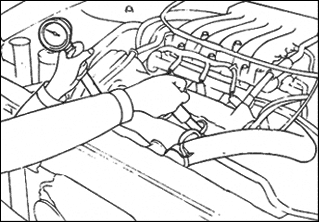Is the fuel pressure OK?
YES
Go to "Check Engine Compression" procedure.
NO
If fuel pressure is too low, check fuel filter for blockage or fuel pump.
If fuel pressure is too high, check fuel pump.
Start the engine with the fuel pump disconnected to reduce the internal pressure of the fuel lines and hoses, and wait until the engine stalls before continuing.
Be sure to reduce the fuel pressure before disconnecting the fuel main pipe and hose, otherwise fuel may spray out, possibly resulting in fire or injury.
Disconnect the battery negative(-) terminal and then connect the fuel pump harness connector.
Install the fuel pressure gauge using the appropriate adapter.
Connect the battery’s negative(-) terminal.
Check that there is no fuel leak from the pressure gauge or connections.
Disconnect the vacuum hose from the pressure regulator and plug the hose end.Measure the fuel pressure at idle.
[Specification] 320 ~ 350kPa (3.26~ 3.57kg/cm², 46.4~50.7 psi)
Measure the fuel pressure when the vacuum hose is connected to the pressure regulator(while engine is running).
[Specification] 250 ~ 280kPa (2.55 ~ 2.86kg/cm², 36.3~40.6 psi)
Is the fuel pressure OK?
YES
Go to "Check Engine Compression" procedure.
NO
If fuel pressure is too low, check fuel filter for blockage or fuel pump.
If fuel pressure is too high, check fuel pump.
Start the engine and wait until the engine coolant temperature reaches 80~95℃(176~205℉).
Start the engine and disconnect the spark plug cables.
Remove the spark plugs.
Crank the engine to remove any foreign material in the cylinders.
Insert the compression gauge into the spark plug hole.
Depress the accelerator pedal to open the throttle fully.
Insert the compression gauge into the spark plug hole.
Crank the engine and read the gauge.
[Specification] 1,200kPa(12.2kg/cm²,170 psi)
[Limit] 12.0kg/cm²(1.18 Mpa ,171 psi)

Check that the pressure differences of the cylinders are below the limit.
[Specification] 100kPa(1.0 kg/cm²,14 psi)
Is a cylinder’s compression or pressure differential outside the specification?
YES
- add a small amount of oil through the spark plug hole, and repeat above steps.
If the addition of oil causes the compression to rise, the cause is a worn or damaged piston ring or cylinder inner surface.
If the compression remains the same, the cause is a burnt or defective valve seat, or pressure is leaking from the gasket.
NO
Engine compression is O.K.
Possibility of defective ECM.Temporarily test with a new ECM and check for proper operation.
If problem is corrected, replace ECM and go to "Verification of Vehicle Repair" procedure.